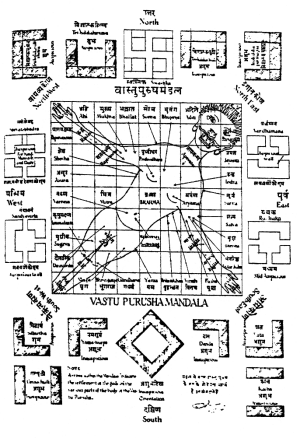
| Vastu Purusha Mandala: Beyond Building Codes |
|---|
Interior Design Program, School of Arch & Design
Philadelphia University
School House Lane & Henry Ave
Philadelphia PA 19144-5497 USA
 During
the medieval ages in India, no single dynastic power served as
the undisputed dispenser of cultural and artistic ideas. However,
despite their regional flourishes, Hindu temple designs displayed
a remarkable unity of aesthetic purposes. This unified philosophy
was codified into a system of rules or canons (a compendium of
architectural guidelines) called the Vastushastras. These canons
were the purview of the priestly class, were intentionally made
very complex so that they were incomprehensible to even skilled
building craftspeople and were seldom challenged.
During
the medieval ages in India, no single dynastic power served as
the undisputed dispenser of cultural and artistic ideas. However,
despite their regional flourishes, Hindu temple designs displayed
a remarkable unity of aesthetic purposes. This unified philosophy
was codified into a system of rules or canons (a compendium of
architectural guidelines) called the Vastushastras. These canons
were the purview of the priestly class, were intentionally made
very complex so that they were incomprehensible to even skilled
building craftspeople and were seldom challenged.
Of all the canons and rules in the Vastushastras, the one that found the most favor with building designers from ancient times to the present day is the Vastu purusha mandala. The Vastu purusha mandala has been defined as "a collection of rules which attempt to facilitate the translation of theological concepts into architectural form." This law of proportions and rhythmic ordering of elements not only found full expression in temples, but extended to residential and urban planning as well. This paper argues that the influence of the Vastu purusha mandala extended beyond building activity to encompass the cultural milieu as well. The first section discusses the principles underlying the Vastu purusha mandala. The application of the Vastu purusha mandala in residential design and city planning is discussed in the second section. The implications of the mandalas on the social milieu are also identified. Finally, the current status of the mandala in contemporary Indian architecture and urban design are identified.
The Vastu purusha mandala (Dhama, 1962)
ABOUT THE AUTHOR
Vini
Nathan is the Director of and
Associate Professor in Interior Design in the School of Architecture
and Design at Philadelphia University, Philadelphia, USA. Her
educational background includes degrees in architecture and interior
design. She worked as an architect for Walker Group/CNI in New
York, a full service design firm specializing in retail design.
She has also taught in interior design and architecture programs
at Virginia Tech, the University of Michigan, Eastern Michigan
University, Michigan State University, the University of Minnesota,
New York Institute of Technology and at her current institution,
Philadelphia University. Her research interests include chaos
theory, design processes, and research methods. She is currently
researching the relationship between mathematics and architectural
canons in traditional and contemporary Indian building designs.
|
Vini Nathan, "Vastu Purusha Mandala", pp. 151-163 in Nexus IV: Architecture and Mathematics, eds. Kim Williams and Jose Francisco Rodrigues, Fucecchio (Florence): Kim Williams Books, 2002. http://www.nexusjournal.com/conferences/N2002-Nathan.html |
|
|
|
|
